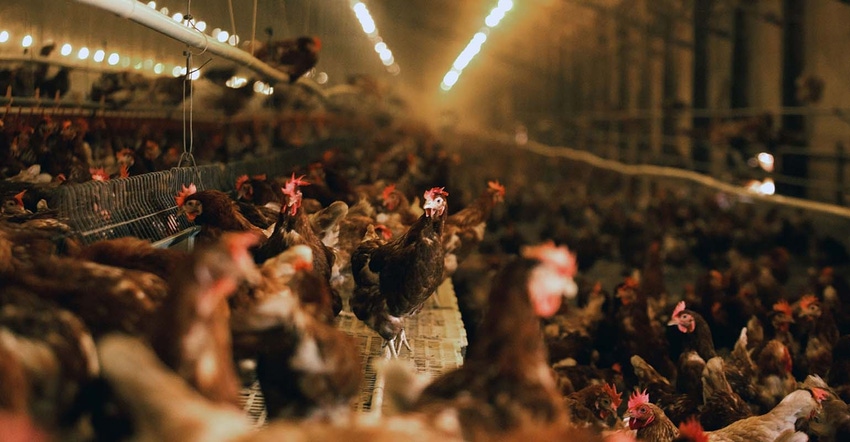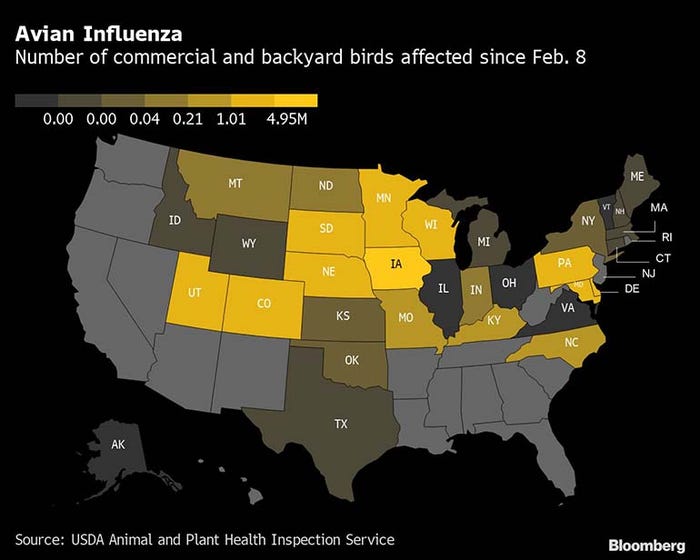
By Zijia Song, Elizabeth Elkin and Michael Hirtzer, with assistance from Jen Skerritt and Dominic Carey
A bird flu virus that’s sweeping across the U.S. is rapidly becoming the country’s worst outbreak, having already killed over 37 million chickens and turkeys and with more deaths expected through next month as farmers perform mass culls across the Midwest.
Under guidance of the federal government, farms must destroy entire commercial flocks if just one bird tests positive for the virus, to stop the spread. That’s leading to distressing scenes across rural America. In Iowa, millions of animals in vast barns are suffocated in high temperatures or with poisonous foam. In Wisconsin, lines of dump trucks have taken days to collect masses of bird carcasses and pile them in unused fields. Neighbors live with the stench of the decaying birds.
The crisis is hurting egg-laying hens and turkeys the most, with the disease largely being propagated by migrating wild birds that swarm above farms and leave droppings that get tracked into poultry houses. That’s probably how the virus contaminated egg operations in Iowa, which produce liquid and powdered eggs that go into restaurant omelets or boxed cake mixes. Further north under the same migration paths lie Minnesota’s turkey farms, which supply everything from deli meats for submarine sandwiches to whole birds for the holidays.
Prices for such products are soaring to records, adding to the fastest pace of U.S. inflation in four decades. The supply deficits triggered by the flu also come as world food prices reach new highs. From the war in Ukraine to adverse weather for crops, it’s all throwing supply chains into turmoil and compounding the crisis that’s pushed millions of people into hunger since the start of the pandemic.
“Just when you thought it couldn’t get any worse, here comes the bird flu,” said Karyn Rispoli, an egg market reporter at commodity researcher Urner Barry.
Ventilation shutdown
Wholesale egg prices touched a record $2.90 a dozen in April in government data. Whole turkeys touched an all-time high $1.47 a pound according to Urner Barry.
The last time bird flu hit the U.S. in 2015, it took the lives of about 50 million animals by the end of the season and cost the federal government over $1 billion dollars, as it handles killing and burying of birds. At the time, the industry beefed up its biosecurity around poultry houses, installing sound cannons to repel wild birds, or even carwashes so that farm trucks wouldn’t bring contamination from one farm to another so that there wouldn’t be a repeat.
This time around, even with that better biosecurity, the industry has failed to prevent the transmission from wild birds, said Michelle Kromm, an executive consultant for the Minnesota Turkey Growers Association. As a precaution, farmers are supposed to go through a laborious process of completely changing their clothing and shoes before entering barns, and making sure all supplies and tools are clean.
Yet weather and migration patterns are making it easier for the virus to win this year. Rare spring snowstorms are originating in the Midwest and travelling up the East Coast, and the cold, wet weather keeps the virus alive for longer, helping it spread. The flu this year is also more lethal than in the past. The deaths so far this season are tracking above previous outbreaks at 37 million chickens and turkeys. The U.S.’s flock of egg-laying hens totals more than 300 million birds (chickens raised for meat, known as broilers, haven’t been as affected).
“We all need to maintain really high awareness that the environment is contaminated,” said Beth Thompson, a veterinarian at the Minnesota Board of Animal Health. The weather “needs to warm up and dry out to kill that virus that’s sitting out there.”

Iowa, the U.S.’s center of egg production, has been hit the worst. One farm, Rembrandt Enterprises, destroyed its giant flock of 5.3 million hens starting in late March using a government-approved yet controversial method called ventilation shutdown plus. The technique, which is being widely used to eliminate millions of chickens at a time during this outbreak, involves closing up barns so that temperatures rise and the animals suffocate over hours. Turkeys can be killed by spraying a firefighting foam that suffocates them.
Rembrandt didn’t respond to requests for comment.
Bird flu is also wreaking havoc in Canada, wiping out almost two million fowl. The virus has never been in multiple provinces at the same time.
“We’re worried. We’re worried for sure,” said Lisa Bishop-Spencer, spokeswoman for Chicken Farmers of Canada.
One person involved in culling infected birds in Colorado has contracted the avian flu, according to the Centers for Disease Control and Prevention. The risk of the bird flu spreading to humans remains low, even with this case, the agency said. Flus that spread from animals to humans are a concern because in rare instances, the result can be a pandemic.
Longer recovery
It won’t be easy to recover from the crisis. In 2015, it took the egg industry over a year to ramp back up, according to Maro Ibarburu-Blanc, a research scientist at Iowa State University’s Egg Industry Center. This time, supplies could be hit for longer because farmers whose operations were affected by the virus may make a transition to cage-free production, which is a long-term trend in the industry, said Mark Jordan, a poultry analyst with LEAP Market Analytics.
Massive outbreaks may continue to plague the U.S. poultry industry as long as bigger bird barns stay in vogue. And the trend is toward bigger.
“We continue to see consolidation of facilities, new facilities continue to be built that are for several million birds,” said John Brunnquell, chief executive officer of Egg Innovations.
©2022 Bloomberg L.P.
About the Author(s)
You May Also Like




